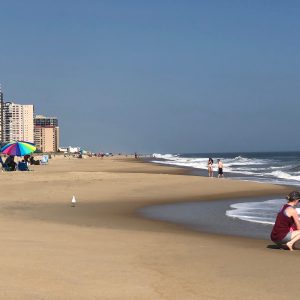ANNAPOLIS, Maryland — Splashes in the pool and boats lazily drifting along the Severn River usually draw the most Marylanders in July or August.
But this year, early October’s record heat kept people, boats and mosquitoes busier outside and air conditioning on longer.
Baltimore Washington International Airport’s blistering 98 degrees broke the 89-degree daily record set in 1986. It also shattered a 97-degree monthly record for the airport set on Oct. 5, 1941.
“Wednesday (is) downright hot,” said National Oceanic and Atmospheric Administration Weather Prediction Center meteorologist Cody Snell. “We’re in a pretty amplified pattern with high pressure in the eastern United States and low pressure in the western United States.”
Meteorologists call this pattern of built-up high pressure and subsequently hot temperatures a ridge, and the overall pattern across the U.S. can be thought of as a sideways S-shaped wave that rises in the east, said Snell.
Not only have we had a hot week, we’ve had a hotter than usual September.
The month of September for Maryland was “four to six degrees above the mean temperature trend (of the United States),” said Stephen Baxter, meteorologist with NOAA’s Climate Prediction Center.
Washington, D.C., has had the warmest September on record too, said Snell.
Lack of soil moisture has also contributed, said Snell. “When we are in dry spells, it’s easier to get hotter,” he said.
“It’s not normal going into October wearing a T-shirt (in the fields) every day,” said Greg Dell, a farmer at family-owned Dell Brothers Inc. farm, in Carroll County, Maryland.
Fortunately for Dell, most of his soybean and corn crops had already matured, so drought was less of a concern for him.
“A year like this, we can get started on harvesting at a decent time,” Dell told Capital News Service. “Last year, when it kept raining, there were spoiled crops in the field because of too much moisture and heat.”
Dell knows that farmers who grow wheat, a crop that is “still very green and trying to grow” are struggling.
“Just the past couple years we’ve been able to increase our yields,” Dell said, as a result, to a certain extent, of increased temperatures.
Eric Luebehusen, a U.S. Drought Monitor meteorologist, echoed that heat does extend the growing season for some crops.
“I don’t recall the last time I saw a hummingbird in October,” said Luebehusen, yet this is what he’s been observing in Jacksonville, Maryland, north of Baltimore.
Asian Tiger mosquitoes, “day-biters,” as Brian Prendergast, program manager of the Maryland Mosquito Control Program called them, are also likely to be active for a longer period of time with warmer days.
These “day-biters” can be carriers of tropical diseases such as Zika, if they bite a person already infected.
In addition, with increased temperatures come increased evaporation and transpiration rates, which are processes plants use to cool themselves down via a release of moisture.
Without enough moisture, the leaves brown out and die, leading to a lack-luster fall foliage, said Luebehusen.
Swimmers from the Pasadena, Maryland, Y and other nearby pools that have already closed for the season, have flocked to the Greater Annapolis Y in Arnold, Maryland, to take advantage of the outdoor pool’s later mid-October closing date, said Emily Hutton, swim director.
Boaters are also taking advantage.
“We’ve had some pretty nice days, keeping boating season going longer,” said Jacob Nold, watch commander at City Dock in Annapolis, Maryland.

The Annapolis Boat Show set-up crew is also enjoying the weather compared to normal October winds and rain they have contended with in past years. But Annapolis Boat Shows President Paul Jacobs, said he’s concerned about heat exhaustion for his staff.
In addition, lifeguards are officially off-duty in Ocean City, Maryland after Sept. 22, but that hasn’t stopped the crowds from coming on the weekends, said Capt. Butch Arbin, of the Ocean City Beach Patrol.
“We’ve been busy, we’ve had a few rescues these past few weekends,” said Arbin. “However, when you have hot weather, you don’t have strong rip currents, because you get less winds that can drive the rip currents,” said Arbin.

In case of an emergency, Arbin keeps a few mobile patrol crews on the beach until Columbus Day.
The state’s power grid felt the strain of people who decided to stay inside.
Baltimore Gas and Electric Co. instituted its emergency energy cycling program Wednesday due to peak demand, a representative said. Customers who have signed up for bill credits have their air conditioning turned off for periods of up to a few hours in order to accommodate the increased demand for energy.
For those who really sweated it out Wednesday, a heat reprieve is around the corner, as a cold front is set to creep in Thursday, said Snell.
The Climate Prediction Center is projecting temperatures through December to have a 45% chance of being above normal, however “such high amplitude anomalies (like today and the past month) would be unlikely,” said Baxter. “While we still favor above-normal temperatures for the month of October, that is in part due to the extreme warmth of yesterday and today.”



You must be logged in to post a comment.